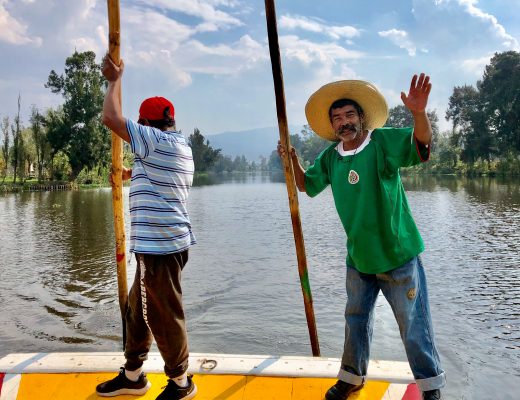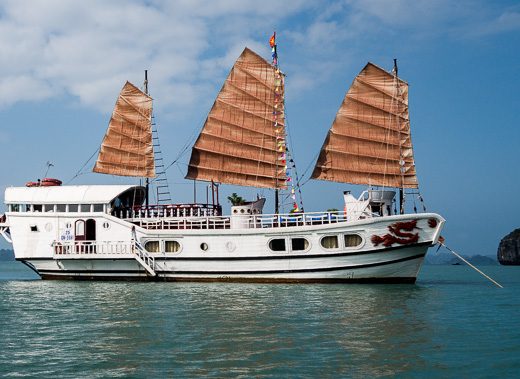**This is a graphic article. It contains explicit information about the crimes against humanity that occurred under the Khmer Rouge in Cambodia from 1975 – 1979. There is nothing fun about this but it is so incredibly important. I hope you read it. We were thanked by every Cambodian we saw on our day touring Choeung Ek and Tuol Sleng. It’s the only way it won’t happen again, they kept telling us.
If you want to read a really excellent summary of the Khmer Rouge’s rise to power, their reign, and their ultimate downfall, check out these articles from one of my favorite blogs. Also, we didn’t take any pictures while we were here. It felt wrong.
It had already been a long day but you wouldn’t have known that from looking at a clock. It was still early and we had only spent 90-minutes at Choeung Ek, but emotionally and mentally we were exhausted.
Our next stop was Tuol Sleng, known also as S-21, one of the more than 200 prisons that Pol Pot and the Khmer Rouge used to torture and kill hundreds of thousands of Cambodians.
Pot had dreams of an agrarian utopia and a society without any social institutions; no banks, no religions, no modern technologies, no education, etc. In April 1975 the Khmer Rouge had taken over Cambodia’s capital, Phnom Penh, and evacuated the 2.5 million people that lived there into the countryside. Many people went to work in the fields, oftentimes without training, where they would starve, get sick, or die from exhaustion.
However, if you were someone who didn’t fit Pot’s ideals, you were instead sent to the killing fields or to a prison like Tuol Sleng. There were a lot of people who didn’t fit into Pot’s utopia: doctors, lawyers, teachers, city dwellers, people who wore glasses, artists, ethnic minorities, religious groups, religious leaders, Westerners, anyone with higher education, anyone who spoke more than one language, or anyone else who was perceived as a threat to the new Communist Regime, including Khmer Rouge soldiers.
It was a 30 minute tuk-tuk ride from the killing fields to Tuol Sleng which gave us a little time to process what we had just seen. Cambodia seemed different now.
Tan, our tuk-tuk driver, turned right off a busy street and we didn’t think much of it. We were in the midst of a bustling area in Phnom Penh, but there on the corner was Tuol Sleng.
We were thrown off by the fact that it was right in the middle of Phnom Penh. The entrance gate was surrounded by street food stalls and buildings that housed cafes and spas. There was even an ATM across the street. It looked like every other corner in Phnom Penh. But this corner was different. It was the location of the torture and murder of 12,000-20,000 people.
We paid $6 each to enter the grounds and received another audio guide. After making our way past the ticketing area we entered the courtyard. Before Tuol Sleng was a security prison for the Khmer Rouge, it was a high school. There were huge mango trees throughout the property and the name of the high school translated to something along the lines of “Mango trees on the hill.” The Khmer Rouge’s name for the area Tuol Sleng, translated to something much different: the “Hill of the Poisonous Trees,” or “Strychnine Hill.”
There were four large buildings that bordered the property. They created a C shape with the courtyard in the middle of the C. On the side that didn’t have buildings, they had essentially closed in the C shape by erecting two fences topped with razor wire. Each building was several stories tall and was set up like most American motels. The stairwells were on each end of the building and the “hallways” were outdoors. Each door led into a former classroom turned torture cell.
The people who didn’t fit into Pot’s ideal were brought here and “interrogated.” Really, they were tortured until they confessed to crimes they may or may not have committed. Those that confessed right away were often tortured longer until the chief of the prison sent the prisoner to the killing fields to be murdered.
But, it often wasn’t just those at S-21 who were killed for confessing. The families of those who confessed were also found and killed because Pot believed “you must pull the weed out by the root.”
The courtyard was divided into several parts. Immediately to our left, directly in front of Building A, there was a makeshift graveyard with 14 white marble tombs. One for each of the last 14 people killed at S-21. We learned that these 14 people were being tortured when Pol Pot’s Khmer Rouge was overtaken in 1979, but since S-21 wasn’t known about, the staff took their time to kill the last prisoners before fleeing.
We entered building A. This building was full of large rooms that had a sole metal bed most often in the middle of the room. The floors were yellow and white checkerboard tile. I will be seeing those until the end of my days. On each bed was a metal box. That is where the prisoners went to the bathroom. Hanging on one of the walls in nearly every room was a huge picture of the room you were standing in. The photograph was taken on the day S-21 was discovered and contained graphic images of the last prisoners killed there. Some were still on their beds, but many were contorted into unnatural positions on the floor. The photos were black and white, but you could tell the dark pools on the yellow and white floor were excrement and blood from the victims.
After entering a few different rooms on the first floor, we looked out toward the courtyard but our view was blocked by a huge sign. The sign had three different languages, Khmer, French, and English, which outlined the rules at S-21. I have written the English verbatim below.
THE SECURITY OF REGULATION
- You must answer accordingly to my question – Don’t turn them away.
- Don’t try to hide the facts by making pretexts this and that You are strictly prohibited to contest me.
- Don’t be a fool for you are a chap who dare to thwart the revolution.
- You must immediately answer my questions without wasting time to reflect.
- Don’t tell me either about your immoralities or the essence of the revolution.
- While getting lashes or electrification you must not cry at all.
- Do nothing, sit still and wait for my orders. If there is no order, keep quiet. When I ask you to do something, you must do it right away without protesting.
- Don’t make pretext about Kampuchea Krom in order to hide your secret or traitor.
- If you don’t follow all the above rules, you shall get many many lashes of electric wire.
- If you disobey any point of my regulations you shall get either ten lashes or five shocks of electric discharge.
Similar to the killing fields, this place just felt heavy.
On our way to Building B, we paused to look at a piece of recess equipment that the Khmer Rouge had turned into a torture device. It was a wooden frame that used to support swings. Yet, the Khmer Rouge had other ideas for it. They would tie the hands of the prisoners behind their backs and hoist them up to hang by their wrists. When the prisoners passed out from the pain, they were stuffed into huge garden pots filled with human excrement head first until they woke and then they were pulled up again.
Building B housed thousands of pictures of prisoners and the staff of S-21 in addition to evidence of the small cells that each classroom had been divided into were still there. We heard stories about the leadership of the Khmer Rouge and saw pictures of Pol Pot. We also learned more about the chief of the S-21 prison, Comrade Duch.
Duch was in charge of S-21 from 1976 until its closure in 1979. It was Duch that ordered the “interrogation,” aka torture of the prisoners. He has since been convicted of crimes against humanity, murder, and torture, and recently was sentenced to life in prison. He is still alive. He is also one of the few punished for their roles in this genocide-like event.
Immaculate documents were kept of the prisoners, each was photographed upon arrival, and a detailed history was taken. During their time at S-21 their confessions were documented, and even the date of murder and tools used for the killing were recorded.
By the time we had exited Building B, we had to sit down. It all had become too much. Every time we pressed play on our audioguide we heard more and more horrific information.
Ben sat down next to me and said, “It only cost $6 to get in here, but I think we’ve paid so much more. I don’t think I can handle anymore.” It wasn’t a financial cost, but we were paying a price learning about the horrors that humans are capable of.
I was torn. I felt as exhausted as Ben, but I also felt that we were doing a disservice by not experiencing everything we could at S-21. Ultimately we decided that it came down to self-preservation. We had seen horrible things that day. We had learned about an awful regime that killed millions. We had seen the worst of humanity. And seeing more of it, I don’t think, would’ve made it more real, or made me appreciate it more.
We are told that Building C was full of tiny cells where prisoners were shackled with little to no food for months. Building D displayed the materials used for torture.
Outside of Building D, there was an area where two of the 12 people who survived S-21 were standing. Chum Mey was one of those 12, and he has since written a book about his ordeal. He was there today, smiling and telling his story. What an incredible human.
We can’t wrap our heads around the evil that transpired here. And we don’t claim to know even the tiniest fraction of what Cambodian’s went through during the Khmer Rouge reign or since. Even today, I’m sure that every person we pass in Cambodia likely has been impacted by this part of their history.
As I am sitting here in Kampot, Cambodia writing this, the fishing boats are puttering by after a long day. Life has continued here. The sun continues to rise and set. Honestly, it’s remarkable. Their resilience and courage is admirable. We just wish it wouldn’t have been needed.


